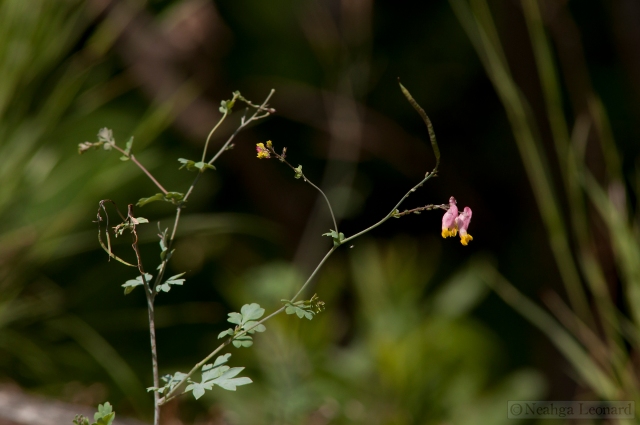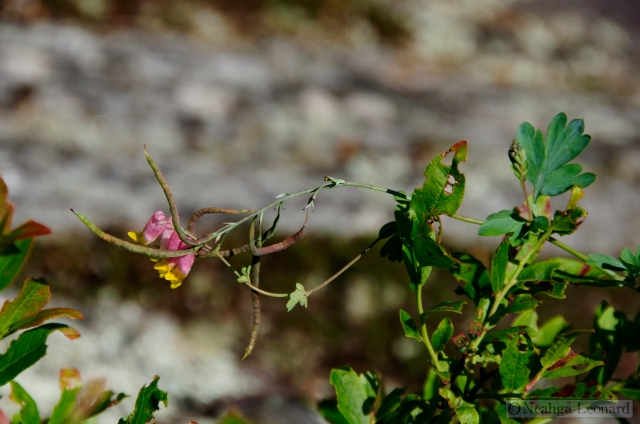A few days ago I bumped into a plant I rarely see in Vermont. It goes by a number of names, The USDA plant database lists it as Rock Harlequin, various other sources call it Tall, Pink, or Pale Corydalis, and the scientific community has settled on Corydalis sempervirens, although it used to be called Capnoides sempervirens. Rock Harlequin ranges from Alaska to the northern Pacific Northwest, across Canada, and down most of the East Coast.
I don’t see Rock Harlequin in Vermont very often, so it’s a bit exciting when I do find it. Here it grows on well drained, dry, rocky, south or west facing slopes, often in the company of Shad Bush, Red Maple, Hop Hornbeam, and/or Red, White, and Chestnut Oak. It is a pretty little plant with yellow-tipped pink flowers of a peculiar shape and long, green bean-like seed pods.
The Corydalis genus is wide spread, with most of its members living in China. It is in the poppy family (Papaveraceae) via the intermediary of the bleeding heart sub-family (Fumariaceae). When I first saw this plant I was really confused. I grew up in California where the California Poppy and the Pacific Bleeding Heart are common. The Rock Harlequin looked like some strange cross between these plants, with oddly asymmetrical flowers. I wasn’t sure exactly what to make of it.
The other branch of the Fumariaceae is the Dicentra genus, most commonly represented in Vermont by Squirrel Corn and Dutchman’s Breeches. These plants have extremely symmetrical flowers.
The leaves are similar and, if you squint, you can see a bit of similarity between the flowers. Dutchman’s Breeches tends to grow in rocky, but damp places, producing lush vegetation. Like Dutchman’s Breeches the Rock Harlequin initially grows all it’s leaves from a basal rosette, but, unlike Dutchman’s Breeches, when it produces a flower stalk there are little leaflets on the stalk as well.
Rock Harlequin is spare, lean, and tough. Its blue-tinged leaves have a leathery feel to them and the flower stalks are wiry, resistant to wind and sun. It is a fire adapted species, which may be why it is unusual to find it in Vermont. The land here is damp, like a sponge left in the sink, fires do not take easily and burns remain small when they do ignite. The patch of flowers I found was growing directly from cracks in the exposed bedrock near small trees that had lived a hard life. All the trees nearby were chest-height or shorter, broken by wind and ice, lightning struck, and starved of water and nutrients. A perfect place for Ericaceae plants, the family that contains blueberries and huckleberries.
Sure enough, the larger Rock Harlequin were growing right on the edge of patches of dwarf blueberries. I tried to get a back-lit photo showing a little of the internal structure of the flower. There is a darker line running through the pink of the flower body which terminates in a spiky yellow rosette. The flower begins growing as a tiny yellow nub which expands, turning pink as it does so. Once the flowers are pollinated, by wind and by ants (how cool is that, ant pollination), long bean-like seedpods grow, containing tough, easily germinated seeds. The seeds need either heat or scarification to germinate, but have extremely high success rates.
In the past Native People managed the land with fire, burning frequently with small, low temperature fires that kept the forest understory clear and promoted the growth of a number of plants. I can’t help but wonder if this plant was more common in the past.



